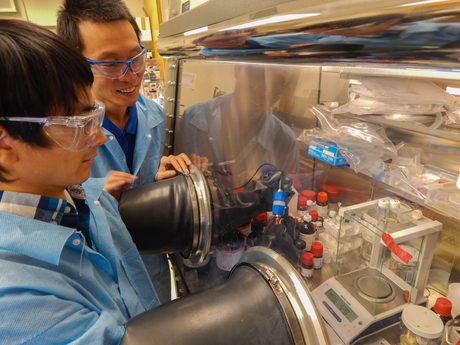Enhancing Li-ion batteries with hydrogen

Lawrence Livermore National Laboratory scientists have found that lithium-ion batteries operate longer and faster when their electrodes are treated with hydrogen.
The growing demand for energy storage emphasises the urgent need for higher-performance batteries. Several key characteristics of lithium-ion battery performance — capacity, voltage and energy density — are ultimately determined by the binding between lithium ions and the electrode material. Subtle changes in the structure, chemistry and shape of an electrode can significantly affect how strongly lithium ions bond to it.
Through experiments and calculations, the Livermore team discovered that hydrogen-treated graphene nanofoam electrodes in the LIBs show higher capacity and faster transport.
“These findings provide qualitative insights in helping the design of graphene-based materials for high-power electrodes,” said Morris Wang, an LLNL materials scientist and co-author of a paper published in Nature Scientific Reports.
Commercial applications of graphene materials for energy storage devices, including lithium-ion batteries and supercapacitors, hinge critically on the ability to produce these materials in large quantities and at low cost. However, the chemical synthesis methods frequently used leave behind significant amounts of atomic hydrogen, whose effect on the electrochemical performance of graphene derivatives is difficult to determine.
Yet Livermore scientists did just that. Their experiments and multiscale calculations reveal that deliberate low-temperature treatment of defect-rich graphene with hydrogen can actually improve rate capacity. Hydrogen interacts with the defects in the graphene and opens small gaps to facilitate easier lithium penetration, which improves the transport. Additional reversible capacity is provided by enhanced lithium binding near edges, where hydrogen is most likely to bind.
To study the involvement of hydrogen and hydrogenated defects in the lithium storage ability of graphene, the team applied various heat treatment conditions combined with hydrogen exposure and looked into the electrochemical performance of 3D graphene nanofoam (GNF) electrodes, which are comprised chiefly of defective graphene. The team used 3D graphene nanofoams due to their numerous potential applications, including hydrogen storage, catalysis, filtration, insulation, energy sorbents, capacitive desalination, supercapacitors and LIBs.
The binder-free nature of graphene 3D foams makes them ideal for mechanistic studies without the complications caused by additives.
“We found a drastically improved rate capacity in graphene nanofoam electrodes after hydrogen treatment. By combining the experimental results with detailed simulations, we were able to trace the improvements to subtle interactions between defects and dissociated hydrogen. This results in some small changes to the graphene chemistry and morphology that turn out to have a surprisingly huge effect on performance,” said LLNL scientist Brandon Wood, another co-author of the paper.
The research suggests that controlled hydrogen treatment may be used as a strategy for optimising lithium transport and reversible storage in other graphene-based anode materials.
Eco-friendly battery for low-income countries
Able to be used more than 8000 times, this battery has an energy density that is comparable to...
Novel material improves stability, efficiency of PSCs
A team of chemists has developed a new material for perovskite solar cells that can be used as a...
Device gathers, stores electricity in remote settings
New research shows the pyroelectrochemical cell, or PEC, harnesses changes in ambient temperature...










